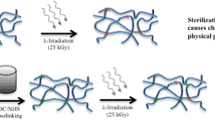Abstract
The objective of this study was to investigate the stability in terms of volume changes and local tissue reactions of dextranomer (Dx)/hyaluronic acid (HA) and collagen implants. A total of 57 rats were included in this study: the control group (nine rats), collagen-injected group (24 rats), and Dx/HA copolymer-injected group (24 rats). Under anesthesia, 0.35 ml of bulking agents was injected subcutaneously in the abdominal area. At 1, 6, and12 months, eight animals of the two implant groups and three animals of the control group were killed. The area of the injected material and surrounding tissue were carefully resected for histopathological examination. Mean volume changes in the Dx/HA copolymer group were 0.56 ± 0.12, 0.43 ± 0.08, and 0.28 ± 0.02 ml at 1, 6, and 12 months, respectively. Mean volume changes in the collagen group were 0.25 ± 0.03, 0.21 ± 0.08, and 0.21 ± 0.01 at 1, 6, and 12 months, respectively. The degree of tissue reaction and fibrosis are more pronounced in the Dx/HA copolymer group at each measurement period after injection.







Similar content being viewed by others
References
Murless B (1938) The injection treatment of stress urinary incontinence. J Obstet Gynaecol Br Emp 45:67–73
Lopez AE, Padron OF, Patsias G, Politano VA (1993) Transurethral polytetrafluoroethylene injection in female patients with urinary continence. J Urol 150:856–858
Politano VA, Small MP, Harper JM, Lynne CM (1974) Periurethral teflon injection for urinary incontinence. J Urol 111:180–183
Malizia AA Jr, Reiman HM, Myers RP et al (1984) Migration and granulomatous reaction after periurethral injection of polytef (Teflon). JAMA 251:3277–3281
Henly DR, Barrett DM, Weiland TL, O’Connor MK, Malizia AA, Wein AJ (1995) Particulate silicone for use in periurethral injections: local tissue effects and search for migration. J Urol 153:2039–2043
Dewan PA, Owen AJ, Byard RW (1995) Long-term histological response to subcutaneously injected Polytef and Bioplastique in a rat model. Br J Urol 76:161–164
Shortliffe LM, Freiha FS, Kessler R, Stamey TA, Constantinou CE (1989) Treatment of urinary incontinence by the periurethral implantation of glutaraldehyde cross-linked collagen. J Urol 141:538–541
Stenberg AM, Sundin A, Larsson BS, Lackgren G, Stenberg A (1997) Lack of distant migration after injection of a 125 iodine labeled dextranomer based implant into the rabbit bladder. J Urol 158:1937–1941
Stenberg AM, Larsson G, Johnson P (2003) Urethral injection for stress urinary incontinence: long-term results with dextranomer/hyaluronic acid copolymer. Int Urogynecol J Pelvic Floor Dysfunct 14:335–338
Appell RA (1994) Collagen injection therapy for urinary incontinence. Urol Clin North Am 21:177–182
Appell RA (1990) New developments: injectables for urethral incompetence in women. Int Urogynecol J 1:117–119
Nataluk EA, Assimos DG, Kroovand RL (1995) Collagen injections for treatment of urinary incontinence secondary to intrinsic sphincter deficiency. J Endourol 9:403–406
Monga AK, Stanton SL (1997) Urodynamics: prediction, outcome and analysis of mechanism for cure of stress incontinence by periurethral collagen. Br J Obstet Gynaecol 104:158–162
Frey P, Mangold S (1995) Physical and histological behavior of a new injectable collagen (GAX 65) implanted into the submucosal space of the mini-pig bladder. J Urol 154:812–815
Su TH, Hsu CY, Chen JC (1999) Injection therapy for stress incontinence in women. Int Urogynecol J Pelvic Floor Dysfunct 10:200–206
Corcos J, Fournier C (1999) Periurethral collagen injection for the treatment of female stress urinary incontinence: 4-year follow-up results. Urology 54:815–818
McGuire EJ, English SF (1997) Periurethral collagen injection for male and female sphincteric incontinence: indications, techniques, and result. World J Urol 15:306–309
Maki DD, Banner MP, Ramchandani P, Stolpen A, Rovner ES, Wein AJ (2000) Injected periurethral collagen for postprostatectomy urinary incontinence: MR and CT appearance. Abdom Imaging 25:658–662
Carr LK, Herschorn S, Leonhardt C (1996) Magnetic resonance imaging after intraurethral collagen injected for stress urinary incontinence. J Urol 155:1253–1255
Defreitas GA, Wilson TS, Zimmern PE, Forte TB (2003) Three-dimensional ultrasonography: an objective outcome tool to assess collagen distribution in women with stress urinary incontinence. Urology 62:232–236
Stenberg A, Larsson E, Lindholm A, Ronneus B, Stenberg A, Lackgren G (1999) Injectable dextranomer-based implant: histopathology, volume changes and DNA-analysis. Scand J Urol Nephrol 33:355–361
Stenberg A, Larsson E, Lackgren G (2003) Endoscopic treatment with dextranomer-hyaluronic acid for vesicoureteral reflux: histological findings. J Urol 169:1109–1113
Author information
Authors and Affiliations
Corresponding author
Additional information
Conflict of interest and source of funding: none.
Rights and permissions
About this article
Cite this article
Elzayat, E.A., Karsenty, G., Bismar, T.A. et al. Volume changes and histological response to injected dextranomer/hyaluronic acid copolymer (Zuidex™) and collagen (Contigen®) in rats. Int Urogynecol J 19, 247–252 (2008). https://doi.org/10.1007/s00192-007-0414-9
Received:
Accepted:
Published:
Issue Date:
DOI: https://doi.org/10.1007/s00192-007-0414-9




